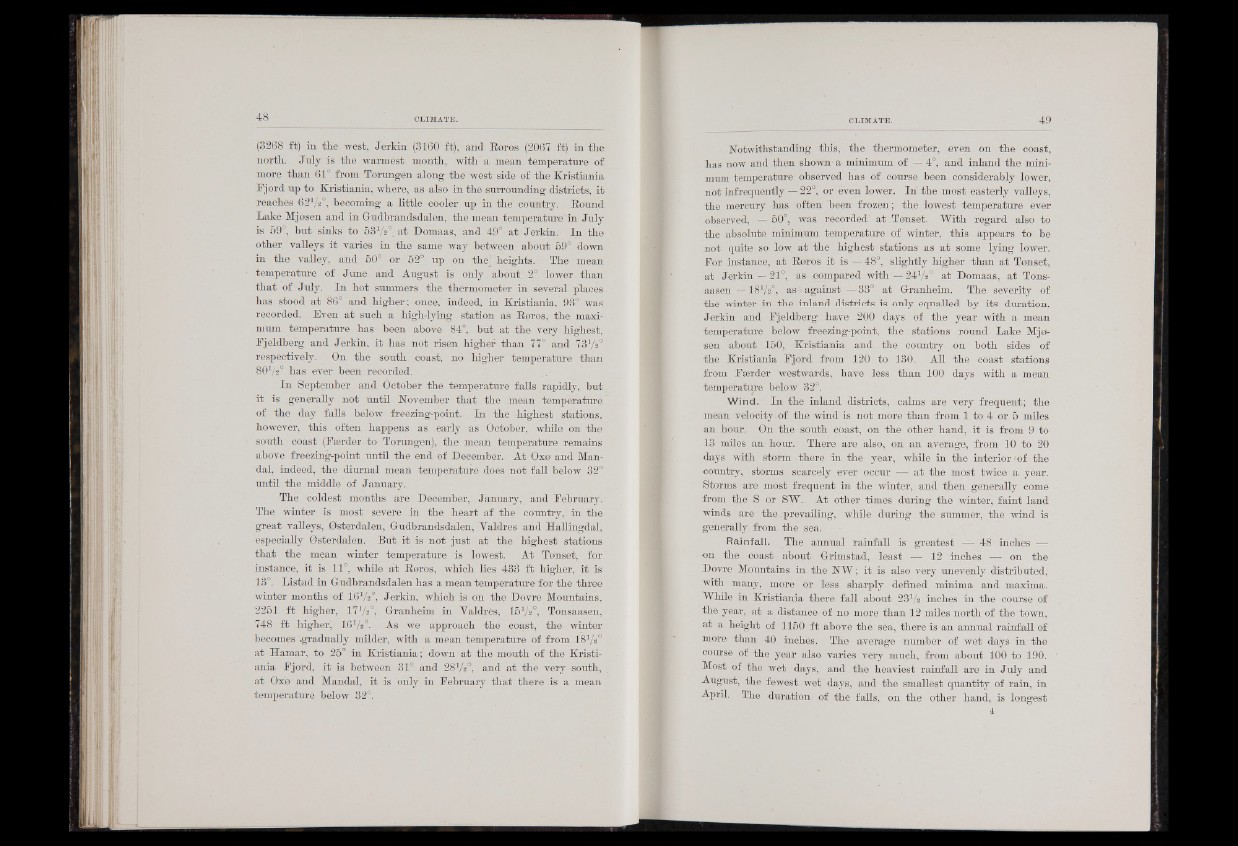
(3268 ft) in the west, Jerkin (3160 ft), and Eeros (2067 ft) in the
north. July is the warmest month, with a mean temperature of
more than 61° from Torungen along the west side of the Kristiania
Fjord np to Kristiania, where, as also in the surrounding districts, it
reaches 6272°, becoming a little cooler up in the country. Bound
Lake Mjesen and in Gudbrandsdalen, the mean temperature in July
is 59°, but sinks to 5 3 7 2 °. at Domaas, and 49° at Jerkin. In the
other valleys it varies in the same way between about 59° down
in the valley, and 50° or 52° up on the) heights. The mean
temperature of June and August is only about. 2° lower than
that of July. In hot summers the thermometer in several places
has stood at 86° and higher; once, indeed, in Kristiania, 93° was
recorded. Even at such a high-lying station as Eeros, the maximum
temperature has been above 84°, but at the very highest,
Fjeldberg and Jerkin, it has not risen higher than 77°' and 737a°-
respectively. On the sonth coast, no higher temperature than
80l/s° has ever been recorded.
In September and October the temperature falls rapidly, hut
it is generally not until November that the mean' temperature
of the day falls below freezing-point. In the -highest stations,
however, this often happens as early as October, while on the
south coast (Feerder to Torungen), the mean temperature remains
above freezing-point until the end of December. At Oxo and Man-
dal, indeed, the diurnal mean temperature does not fall below 32°
until the middle of January.
The coldest months are December, January, and February.
The winter is most severe in the heart af the country, in the
great valleys, Osterdalen, Gudbrandsdalen, Yaldres and Hallingdal,
especially Osterdalen. But it is not just at the highest stations
that the mean winter temperature is lowest. At Tenset, for
instance, it is 11°, while at Eeros, which lies 433 ft higher, it is
13°. Listad in Gudbrandsdalen has a mean temperature for the three
winter months of 167s°, Jerkin, which is on the Dovre Mountains,
2251 ft higher,. 177s'°, Granheim in Yaldres, 1572°, Tonsaasen,
748 ft higher) 1672°. As we approach the coast, the winter
becomes .gradually milder, with a mean temperature of from 187a°
at Hamar, to 25° in Kristiania; down at the mouth of the Kristiania
Pjord, it is between 31° and 287a°, and at the very south,
at Oxo and Mandal, it is only in February that there is a mean
temperature below 32°.
Notwithstanding this, the thermometer, even on the coast,
has now and then shown-a minimum of — 4°, and inland the minimum
temperature observed has of course been considerably lower,
not infrequently — 22°, or even lower. In the most easterly valleys,
the mercury has often been frozen; the lowest temperature ever
observed,¡IBS 50°, was recorded' at Tonset. With regard also to
the absolute minimum temperature of winter, this appears to be
not quite so low at the highest stations as at some lying lower.
For instance, at Eeros it isE- 48 slightly higher than at Tenset,
■at Jerkin — 21°, as compared w ith—247b° at Domaas, at Tonsaasen
— 1872°, as - against -H33° at Granheim. The severity of
the winter in the inland districts is only equalled by its duration.
Jerkin and Fjeldberg have 200 days of the year with a mean
temperature below freezing-point, the stations round Lake Mjo-
sen about 150, Kristiania and the country on both sides of
the Kristiania Fjord from 120 to 130. All the coast stations
from Feerder westwards, have less than 100 days with a mean
temperature below 32°.
Wind. In the inland districts, calms are very frequent; the
mean velocity of the wind is not more than from 1 to 4 or 5 miles
an hour. On the south coast, on the other hand, it is from 9 to
13 miles an hour. There are also, on an average, from 10 to 20.
days with storm there in the year, while in the interior'of the
country, storms scarcely ever occur - 5 at the most twice a year.
Storms are most frequent in the winter, and then generally come
from the S or SW. At other times during the winter, faint land
winds are the. prey ailing, while during the summer, the wind is
generally from the sea.
Rainfall. The annual rainfall is greatest |1 |||4 8 inches —
on the coast about Grimstad, least raga 12 inches on the
Dovre Mountains in the NW ; it is also very unevenly distributed,!
with many, more or less sharply defined minima and maxima.
While in Kristiania there fall about 231/a inches in the course of
the year, at a distance of no more than 12 miles north of the town,
at a height of 1150 ft above the sea, there is an annual rainfall of
more than 40 inches. The average number of wet days in the
course of the year also varies very much, from about 100 to 190.
Most of the wet days, and the heaviest rainfall are in July and
August, the fewest wet days, and the smallest quantity of rain, in
April. The duration of the falls, on the other hand, is longest
4